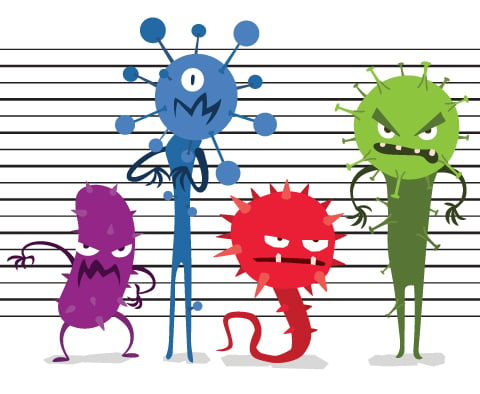Methicillin-Resistant Staphylococcus Aureus Infection
Methicillin-resistant Staphylococcus aureus (MRSA—pronounced “MUR-sa”) is caused by a type of staph bacteria. A MRSA infection is especially difficult to treat because this type of staph bacteria has become resistant to many antibiotics commonly used to treat other staph infections.
Staph infections, including those caused by MRSA, can spread in hospitals and other healthcare facilities such as nursing homes and dialysis centers. MRSA infections can also spread among healthy people in the community where you live, work, and go to school. This type of MRSA most often causes skin infections and is usually spread by skin-to-skin contact in crowded places. The infection can spread through contact with people such as athletes, child care workers, or military personnel in barracks — or something carrying MRSA, such as gym equipment, towels, or razors that have touched infected skin. Skin that is not intact, meaning skin that is cut or scraped, is often the site of a MRSA infection.
Anyone can get a MRSA infection. Approximately 5% of patients in U.S. hospitals carry MRSA in their nose or on their skin. People with medical devices inserted in their bodies are at higher risk of a MRSA infection, and people who inject drugs are 16 times more likely to develop a serious staph infection such as a MRSA infection. It is possible that the opioid epidemic is connected to the rise of staph infections in some communities.
If left untreated, MRSA infections can become severe. In some cases, a MRSA infection can cause pneumonia. It can also cause sepsis, which is the body’s overwhelming and life-threatening response to an infection. Getting medical care early makes it less likely that the infection will become serious.
Symptoms of a MRSA Infection
In general, you can’t tell by looking at your skin if it is a staph infection, which includes MRSA infections. The symptoms depend on the part of the body that is infected. Most MRSA infections appear as a bump or infected area on the skin. Some MRSA infections can be confused with a spider bite. Symptoms can be accompanied by a fever and can include:
- Swelling
- Warmth to the touch
- Redness
- Pain
- Pus or other drainage
If you have a cut or sore that doesn’t get better after three or four days, and especially if you see one or more red streaks branching out away from the cut, you should call your doctor.
MicroGenDX Test Used in Diagnosing MRSA Infections
Generally, MRSA is tested for before surgery or when a wound is not healing. In most cases you need a laboratory test that your doctor can order to determine the cause of the infection.
An evaluation and culture (growing microbes from your sample in a lab) are often used to diagnose infections. However, standard cultures may come back negative even when you actually do have an infection, and that means your infection won’t be treated. Instead of relying on culture, a MicroGenDX test detects MRSA DNA in your sample along with how much of it is present, and uses that information to list the drugs that can best treat it.
You can order the MicroGenDX MRSA | PCR Only test and get complete instructions here: https://microgendx.com/product/mrsa-pcr-only/
Providing a Sample for the MRSA Infection Test
To collect a sample, your doctor will use the nasal swab method, which has been shown to be effective in diagnosing a MRSA infection. To collect the sample, your doctor will insert the swab into your nostril and rotate it for about three seconds. Your doctor will repeat this process in the other nostril before packaging the swab in its transport container.
Everything you need to know about how samples for the MRSA Infection Test are taken is included with the MRSA | PCR Only test and is also available online on the product page. The instructions included with your test contain illustrations that will help you to help your doctor collect a sample without contaminating it. It is always important to obtain a proper sample by following the instructions for collecting the sample, as well as when packaging and shipping it. For example, with either method, be sure not to contaminate the sample by touching it with your hands. For best results, you must be off all antibiotics for two days before the sample is collected. However, if this is not possible, the test can still be run.
Medical Specialties Treating MRSA Infections
A primary care physician is the first contact for treatment; an infectious disease specialist should be consulted for advanced care.
How MRSA Infections Are Treated
It is essential to know what microbes are present in wounds that won’t heal, and MicroGenDX diagnostic testing does just that. Molecular testing is 20 times more precise than other methods when identifying microbial species, so your doctor can select appropriate antimicrobial treatment options.
It is important to know that not all antibiotics work for all bacteria, and some even work differently in different areas of the body. This is especially true for MRSA infections. Your doctor should consult the "antimicrobials for consideration" chart on your MicroGenDX report to decide which treatment is right for you.
It is important to complete the full course of medication as it is prescribed, even when symptoms begin to clear up before you are treated. All MicroGenDX diagnostic tests include detection of antibiotic resistance genes in your sample and provide alternative antibiotics for your doctor to consider prescribing to you.
References

